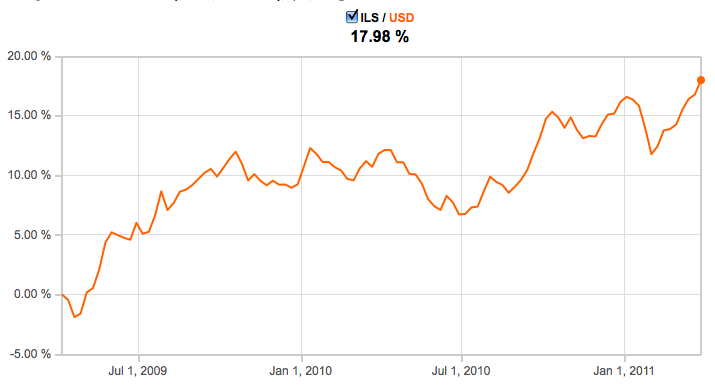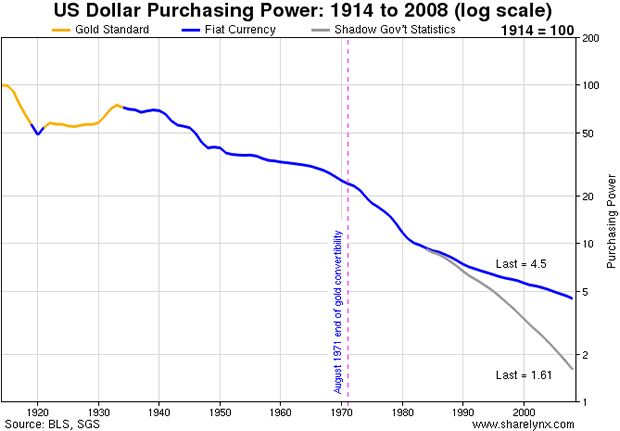The dramatic events of the global sub-prime crisis, credit crunch, ensuing tumble of home prices and the stock market in 2008/2009 have damaged many families’ financial situation, shaken their confidence, and caused much anxiety regarding their financial future. Our natural ability to adapt, however, makes us more inclined to “adjust” to our new life circumstances, not realizing the bigger danger that is coming.
If you’ve never been exposed to the information you are about to read, consider this article a warning about your personal finances. By reading this information you are being given a window of opportunity to protect yourself and your family savings now. This can be done with relative ease. Though it may take a few minutes to read the full article, it could help secure your family finances.
Currency Erosion
With the stock market recovering and employment reports showing some positive signs, officials in the U.S. government - and more importantly leading American economists - are claiming that the U.S. economy is on a slow mend. They explain that market cycles are kicking in and that better times are inevitably ahead. However, over the past few years, the U.S. government has taken on trillions of dollars of debts incurred by the crisis and its aftershocks, provided expensive bailouts, and printed huge amounts of currency to fund the TARP and two Quantitative Easing programs so far. Because of these actions and its easy-money policy over the past three decades, the U.S. (the largest debtor in the world) is now in a precarious situation, as it goes further into debt, while simultaneously weakening its currency.
The consequences of inflation and the assumption of all this debt by the U.S. Treasury have not yet been fully felt by the American economy. When the inevitable results of such monetary policy hit, the savings of millions of people holding all of their assets in American dollars may be completely wiped out. It will happen because commodity prices (raw materials, metals, oil, and food) will rise dramatically, while the value of the dollars they are holding will greatly decline. This dynamic is already beginning to manifest. The majority of Americans are either not recognizing this phenomenon or don’t know what they can do to protect themselves.
Imagine if the U.S. government devalued the dollar by a double digit percentage in one day. Massive panic would breakout causing people to try and take drastic steps to save the value of their savings. By then, of course, it would be too late. But the devaluation is already underway. The U.S. dollar (U.S. Dollar Index) has lost an average of 11% against leading global currencies in the past two years because of the global implications of the U.S. sub-prime, debt-induced financial crisis. The Israeli Shekel in that same time has strengthened 18% against the dollar.
Even people holding their savings in seemly solid U.S. investments or accounts, which are in some cases tax-free or tax-deferred, are in fact losing (compared with the alternative), because the value of their money is eroding daily. This erosion is not temporary.
Loss of Buying Power
Several economic forces are posing a great threat to the American way of life and the value of U.S. currency. Consider what is happening in the world today. In the Middle East, Europe and other parts of the world, there is civil unrest, because of lack of employment and the rising commodity prices. In fact, in some Middle East countries this has already caused regime change. Commodity prices are rising all over the globe, and while in America prices of food, health care, clothing etc. have already gone up, the government continues to report low inflation rates (CPI - 2.11%, February 2011). The reality of anyone who shops regularly is that their buying power has already decreased, because wages and interest rates are not keeping up with the price increases.
Liz Ann Sonders, Chief Economist for Charles Schwab, explained the paradox by commenting on the way the government has changed how it measures and reports on inflation: "Over the past 30 years, major changes have been made to the calculation of the Consumer Price Index (the government inflation measure) due to "re-selection and reclassification of areas, items and outlets, [and] to the development of new systems for data collection and processing," according to the Bureau of Labor Statistics. If you eliminate those adjustments and calculate CPI as it would have been calculated in 1980, it [inflation] would be nearly 12 percent today...” (Charles Schwab Investing Insights, June 2008).
Unmanageable Debt
Quantitative Easing and America’s deficit spending are weakening the U.S. dollar in the global markets. And yet, the Federal Reserve is currently deciding on QE3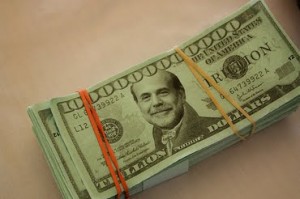 , a third round of money printing, while the Treasury is requesting America’s debt ceiling (a limit set by law) be raised, so that they can go further into debt. As it stands today, America is finding it increasingly difficult to get foreign investors to lend money, via the purchase of its Treasury bonds. Some experts predict that by the end of 2011 America’s government borrowing will reach a point where they will no longer be able to even afford the interest payments on their loans.
, a third round of money printing, while the Treasury is requesting America’s debt ceiling (a limit set by law) be raised, so that they can go further into debt. As it stands today, America is finding it increasingly difficult to get foreign investors to lend money, via the purchase of its Treasury bonds. Some experts predict that by the end of 2011 America’s government borrowing will reach a point where they will no longer be able to even afford the interest payments on their loans.
As this becomes more clear to foreign investors in U.S. government debt, they will decide to sell (dump) their government bonds and dollar-denominated assets, causing the currency to tumble. This dynamic will also cause other countries to prefer payments (for trade and interest on debts) in currencies other than the U.S. dollar, causing the cost of America’s debt to dramatically increase.
This in turn, will drive the cost of dollar-denominated commodities up much higher and much faster, wiping out people’s dollar-based savings, as they try to weather the devastating economic conditions. Even today countries that have traditionally helped keep the dollar’s value propped up (Europe, Japan and China) are losing their appetite to keep sinking more of their money into U.S. debt.
Drastic Measures
The weakening of a county’s currency leads to inflation that can eventually shut down the economy, because producing or importing food and goods costs too much and people have too little to pay for it. In the past century, examples around the world (such as Britain, Yugoslavia, Ukraine, Brazil, etc.) show that when this occurs, governments take several, drastic measures to fight this crisis. They print more money, appropriate citizen funds (like nationalizing retirement programs), limit people’s access to their capital, and many times create a new currency, devaluing everyone’s money overnight.
The British pound, that had enjoyed being the world’s reserve currency for over 200 years, was devalued 14% overnight by its government in 1967. By 1975, their inflation rate for one year was 26.9%. Massive inflation causes people to refuse using their local currency, which further exacerbates the problem, as they lose even more money trading their worthless currency for a stronger one.
The Risk to the U.S. Dollar
Another key reason the dollar is still afloat and prices in the U.S. are relatively low is the U.S. government’s ability to legally print more dollars,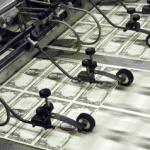 because it is the current global trade (reserve) currency. It became the world’s reserve currency after World War II, based on the strength of its economy. What this means is that currently, foreign governments pay for goods, such as oil, in a foreign currency – U.S. dollars. These governments must ensure they don’t go too far into debt, producing more than they consume, in order to maintain the strength of their currency.
because it is the current global trade (reserve) currency. It became the world’s reserve currency after World War II, based on the strength of its economy. What this means is that currently, foreign governments pay for goods, such as oil, in a foreign currency – U.S. dollars. These governments must ensure they don’t go too far into debt, producing more than they consume, in order to maintain the strength of their currency.
But the U.S. enjoys a special status, being the world’s reserve currency, and has not had to carefully watch its productivity and related spending. This is why, for example, the price of oil in the U.S. is much lower than its price around the world. America has not had to pay for its goods in a foreign currency - yet.
On April 4, 2011 the price of oil was $109 a barrel. Cotton prices are at record levels. Food prices are back at their 2008 highs. Typically, such commodity price increases would send Central Banks running to the U.S. dollar to secure the value of their savings, as these goods are traded between countries based on the U.S. dollar. But, in fact the opposite is happening. Central Banks are shedding U.S. dollars, reducing their holdings by about $9 billion in Q1, 2011 (according to Nomura Securities’ Jens Nordvig, Global Head of G10 FX Strategy).
China, Japan, Russia and Brazil have reportedly already met without the U.S. to discuss an alternative currency for oil dealings (reported by the British Independent). In past years, China’s holdings in the dollar, to pay for their growing oil needs, has been sharply increasing, as their economy develops.
But, starting in 2009 for the first time, and indeed since then, China (the largest single holder of U.S. debt) has been decreasing their holding in the dollar, turning instead to the Japanese yen, the Euro and their own currency. This decline is in line with their intentions to move away from the dollar, as the trading currency for global oil dealings. It has been reported that China has embarked upon a nine year plan to get out of the dollar. There have been further reports that China and Russia plan to trade between themselves using their own currencies and not the dollar. All of these developments continually bring down the global demand for the U.S. dollar.
Moving Away From the Dollar
As this happens, it will be harder and harder to “get rid” of U.S. currency. Mexico, that once allowed the U.S. dollar as an alternate currency at banks and places of business, now disallows usage and exchange of dollars at most business and banks. Reuters reports it is hard to exchange dollars in countries like India, China etc. Even in the United States local currencies have emerged, mostly in the Midwest; local stores are already accepting currencies other than the U.S. dollar. Regardless of the circumstances of each of these particular events, the reality is that there is more and more personal and global activity favoring other currencies over the dollar.
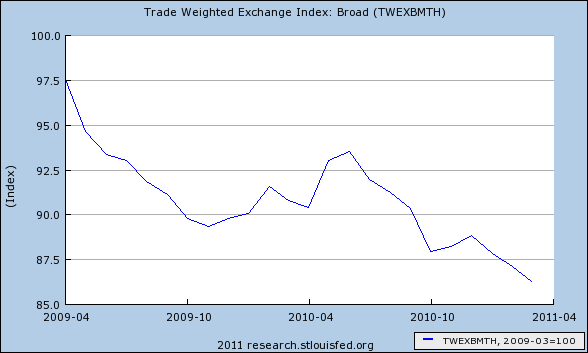
Trade Weighted US dollar Index (Broad index) is a measure of the value of the US dollar relative to other world currencies (here showing a 14% decline in the past two years). Source: St. Louis Federal Reserve Bank
In October 2010, U.S. Secretary of Treasury Tim Geithner vowed that the U.S. would not devalue its currency. The mere fact that a Secretary of Treasury has to make such an announcement should be a red flag for anyone holding all of their money in dollars. Jim Rogers, a world leading investor and billionaire, warns that the U.S. dollar is facing the demise of its status as the world’s reserve currency. When this happens, the U.S. currency and buying power will decrease dramatically because there will be an abundance of dollars that everyone will be looking to unload. He predicts a decline in the dollar to historic "multi-multi decade new lows" as a long-term inevitability, and fears that the time frame for a collapse is sooner than previously thought.
One World Currency
Robert Zeollick, President of the World Bank, said that “the United States would be mistaken to take for granted the dollar’s place as the world’s predominant reserve currency”. There continues to be intense pressure primarily from Russia and China to introduce another currency as the reserve currency, because the effects of the recent American crisis were so far reaching globally, and world financial leaders do not want to see a repeat of this kind of effect.
Since the world’s economic leaders do not see a way for the U.S to recover, as it continues to go further into debt, they want to prevent their countries from dependence on the dollar. Countries want to minimize the effects of the declining U.S. economy on their own economies, as the U.S. sinks further into debt and towards high inflation. Ricardo Amaral, thought leader for Brazil’s economy, said, “the days of the U.S. dollar playing that special role that created an international monetary system that revolved around the U.S. dollar as its main currency has reached the end of the line, since today that system is very sick and it is dying a slow death.”
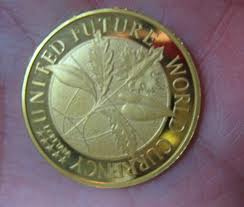 Furthermore, the International Monetary Fund (IMF), the intergovernmental organization overseeing the global financial system, is already calling for a global currency called the “Bancor” to be established for global trade, to be run by a global bank that would be set up in order to manage this currency and global trading in it. When the U.S. dollar stops being the world’s reserve currency, the demand for dollars will decrease instantly, and the interest on America’s loans will skyrocket.
Furthermore, the International Monetary Fund (IMF), the intergovernmental organization overseeing the global financial system, is already calling for a global currency called the “Bancor” to be established for global trade, to be run by a global bank that would be set up in order to manage this currency and global trading in it. When the U.S. dollar stops being the world’s reserve currency, the demand for dollars will decrease instantly, and the interest on America’s loans will skyrocket.
Questionable Safety in State Investments
The state of the U.S. Treasury and its debt is highly concerning, but it is not only the Federal Government that is in trouble. Forty-six U.S. state governments face huge budget shortfalls for 2011. Because they cannot print money to cover their debt, and the massive federal aid has run out, they are resorting to other measures to pay their huge debt.
In Arizona the state is selling its government buildings (and renting instead). In California they are releasing 4% of prison population early, putting criminals back into society. In Georgia they are enacting “dead peasant” insurance policies, whereby upon a state employee’s death, life insurance payouts are paid to the state, not the individual. Many U.S. states are considering legalizing gambling to increase revenues. Many American’s seeking solid investment vehicles have much of their capital invested in municipal bonds, because of the tax exemption this type of bond typically offers. Given the financial state of federal and state government, state and municipal bonds can no longer be considered a safe haven. Of course, as explained above, U.S. Treasury bonds, and other dollar-denominated investments, should no longer be regarded blindly as “secure”.
America’s economy is in bad shape. Today, over 42 million Americans use food stamps, which is 17.5% higher than last year. That represents a staggering 14% of the population, up 58.5% from August 2007, before the recession began. The news website MSN claims 43% of American families still spend more than they earn. It’s not only families who are still living the culture of debt.
For example, “For Profit” education institutions are accepting large amounts of students who qualify for student grants and loans from the government, putting the burden of payment for all of these benefits on the U.S. taxpayer. Many experts consider unemployment rate calculations in American misleading, as they only report on those receiving benefits, but once their benefits run out, these unemployed are no longer reported as unemployed (though they haven’t found a job).
Also, the coveted highest AAA credit rating, once held by 61 American companies in 1979, has steadily declined to only four today. The U.S. government itself is in danger of losing its AAA credit rating as well. The most recent initiative discussed to deal in part with America’s debt is a new plan that will “encourage” by law Americans to use their 401K and IRA accounts to purchase U.S. Treasury bonds. By succumbing to the incentives offered by this plan, or by legally being forced to do this, Americans will be sinking their hard earned income into investments of undoubtedly questionable quality.
What Can I Do?
In light of all of these indicators, smart investors are taking action. Bill Gross, the highly respected manager of the word’s largest bond fund (PIMCO) advises Americans in 2011 to get exposure to currency other than the dollar. His fund recently purged all holdings of U.S. Treasuries. And he continues, stating that you should find countries that are under control financially, and invest in them.
It is essential that an American, or an investor in dollar-based assets, understands that by sitting by and doing nothing, you are in fact taking a financial haircut. There is a big financial price to pay for continued U.S. deficit spending and it’s already takings its toll. The government has to make no radical moves at this point, and Americans are losing buying power daily while their dollars are eroding.The biggest damage year over year will be to those who hold all of their assets in dollars.
There is a big financial price to pay for continued U.S. deficit spending and it’s already takings its toll. The government has to make no radical moves at this point, and Americans are losing buying power daily while their dollars are eroding.The biggest damage year over year will be to those who hold all of their assets in dollars.
So, in order to protect your savings and your family’s standard of living, you need to strongly consider acting now while you are still in position to do so:
- Get at least some of your money out of the dollar and into another strong currency, where it will not erode (and even grow)
- Get at least some of your savings out of the United States where it can not be appropriated or manipulated
- Diversify your investment asset classes (different kinds of assets), so that you do not have all of your eggs in one basket
Safety in Israel
 Israel’s government has a much smaller deficit in percentage terms than most developed nations - in 2010, Israel's deficit was 4.8% of GDP, vs. 10.5%, 9.6%, 8.3% and 7.7% for the U.S., U.K., Germany and Japan respectively. In fact, Israel has had a Current Account surplus since 2003, which is now 3% of GDP.
Israel’s government has a much smaller deficit in percentage terms than most developed nations - in 2010, Israel's deficit was 4.8% of GDP, vs. 10.5%, 9.6%, 8.3% and 7.7% for the U.S., U.K., Germany and Japan respectively. In fact, Israel has had a Current Account surplus since 2003, which is now 3% of GDP.
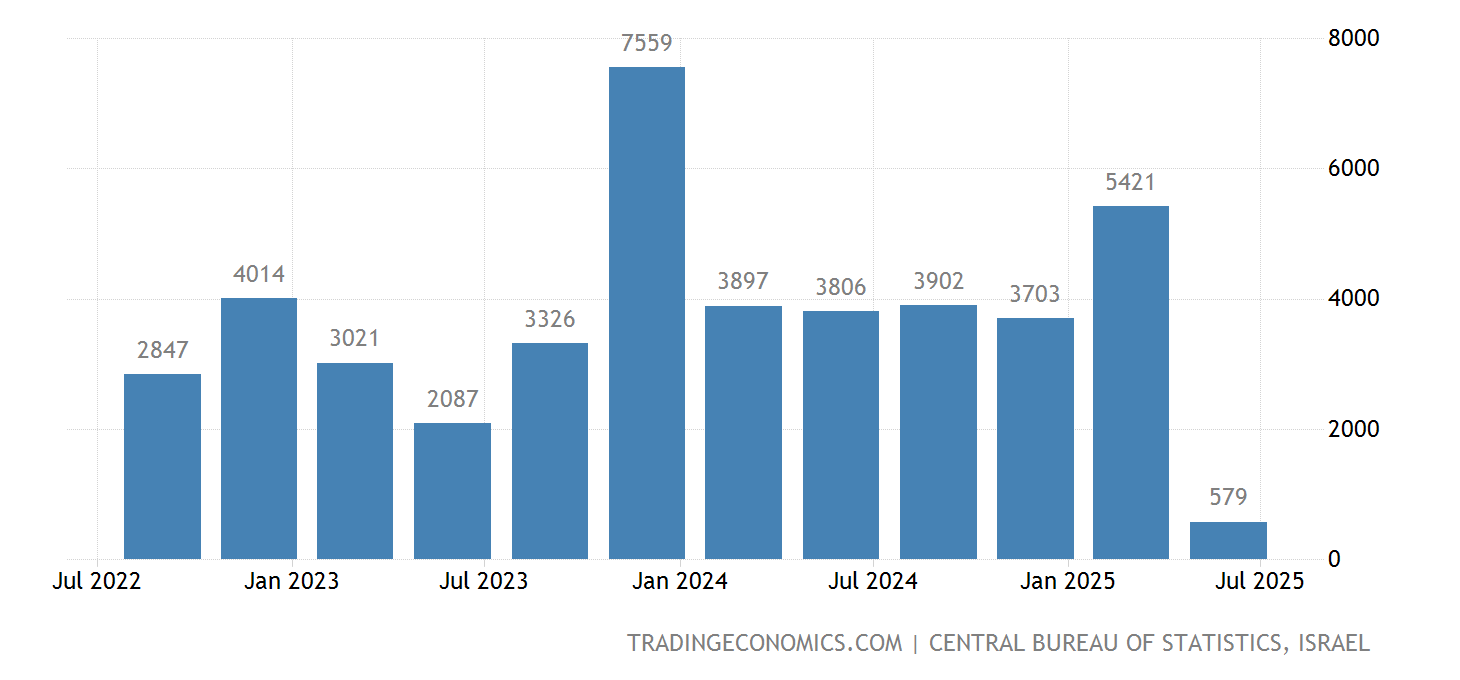
Its economy is strong and was less damaged by the global crisis, because of minimal exposure to the U.S. sub-prime mortgages and its conservative fiscal policy. The Israeli government has taken a conservative approach to managing inflation, real estate loans, economic growth and interest rates. Since the global crisis, Israel’s economy has grown faster than almost all developed nation, with recent GDP growth of 7.7% in Q4, 2010. Israel was one of the first nations to begin raising interest rates (current Bank of Israel base rate of 3.25% vs. U.S. rate of 0-0.25%), making it an attractive investment destination, especially for fixed-income investments (bonds).
The Israeli stock market has outperformed the U.S. market in the past five years by far: the Tel Aviv 25 index returned 62% vs. the S&P 500’s 3% return during that time. Its low unemployment rate (6.1%) and high investment in hi-tech and R&D make Israel a world-leading innovator. The strength of the economy has led to the strengthening of its currency against other world currencies. The Israeli shekel has gained over 22% against the dollar in the past two years.
Opening an investment account in Israel enables investors to move their funds into the Israeli market (and shekels) freely and immediately, now and in the future. You will be able to hold your money in a strong currency and enjoy the fruit of Israel’s strong economy. For more on Israel as an investment destination, read the Wise Money Israel series “Should I Consider Investing in Israel?”
Conclusion
We have just come through an upsetting global economic crisis, one that threatened the world’s financial future. We all want to believe that something like this won’t happen again, at least in the near term. But, the U.S. economy is not well. The root causes of the economic shortfalls the U.S. and indeed the global economy face are still unsolved. Unemployment and inflation reporting in the U.S. is artificially low, and the government continues to devalue its currency by printing more money and going further and further into debt. The U.S. dollar’s status as the world’s reserve currency has allowed the U.S. government to sell foreign investors government debt cheaply, buy imports inexpensively, and create a relative high national standard of living without the real economic strength (productivity) to back that lifestyle.
As other nations begin to disengage from investments in the dollar and U.S. government debt, we’re likely to see another great collapse of the U.S. economy, erosion of your dollar’s buying power, and hyperinflation. International pressure is mounting to move away from the U.S. dollar as the world’s reserve currency, which will flood the market and weaken it even more.
In times like these, diversification, including placing some of your capital outside of the U.S., is prudent. Israel is one such destination that could help you weather the coming storm.
Most of us shy away from change. Human nature loves the status quo: it’s just easier (and more comfortable) to leave things the way they are and hope for better times. We can learn a lesson from the Jewish people in Germany prior to the Holocaust. They saw the rise of the Nazi party, but convinced themselves the situation was not as bad as it truly was. Their denial of the current reality, desire to hang on to their German wealth and optimism that the future would improve blinded them. Many did not prepare an escape route for their money and their families in time and by the time most woke up, it was too late.
They imagined their current riches and position would carry them through and they passed up opportunities to save themselves while they could. The purpose of this article is to raise your awareness, so you can make changes to where and how your financial assets are allocated now. It is an opportunity not to be missed.
Sources: U.S. Department of Treasury, U.S. Department of Agriculture, The Wall Street Journal, Standard & Poor's, CNBC, MSN, The World Bank, Ricardo C. Amaral - Brazzil Magazine, International Monetary Fund (IMF), Stanberry & Associates Investment Research, Foresight Group, Organization for Economic Co-operation and Development (OECD), U.S. Department of Labor Bureau of Labor Statistics, Charles Schwab Corporation, The Independent


